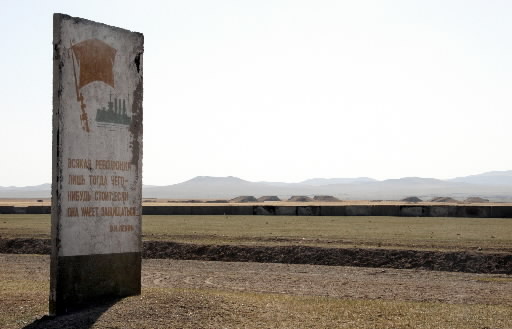Nuclear weapons can be eliminated: Chapter 3, Part 2
Jun. 20, 2009
Chapter 3: Mongolia's challenge
Part 2: Escaping the "nuclear umbrella"
by Keisuke Yoshihara, Staff Writer
Active contributions for nuclear non-proliferation
I had been riding in the car for roughly 30 minutes, traveling over an unpaved road from downtown Ulaanbaatar, the capital of Mongolia, toward the east. The car stopped at the edge of eastern Ulaanbaatar, an area known as the “coal district.” Across the grassy plain, I spotted hangers for fighter jets. Today, this former Soviet military base is used by Mongolia’s air force.
Along the road toward the gates of the compound stands a remnant of the old Soviet military. Russian mottos linger on a concrete wall: “Adhere to the spirit of revolution.” “Uphold one notion: Achieve military expertise.” These are the sentiments of Lenin.
After Mongolia shrugged off Soviet rule and became a democratic state, it initiated a policy of denuclearization. This policy, which seeks to establish a nuclear-weapon-free zone for its territory, is consistent with the nation’s wish of getting out from under the Russian “nuclear umbrella.”
“Mongolia’s territory juts down toward China, doesn’t it?” said Sereeter Galsan Jamts, 57, chief of the Center of Defense Studies at the Institute for Strategic Studies as he explained the significance of Mongolia’s denuclearization policy by pointing his finger at a map. “The Soviet Union used Mongolia as a foothold for confronting China,” Mr. Galsan Jamts continued. “Mongolia was protected by the Soviet Union, but our reliance on nuclear weapons meant that our nation could have been attacked.”
In the 1960s, when tension reached a peak between the Soviet Union and China, about 75,000 Soviet troops are said to have been stationed in Mongolian territory at some six major military bases.
I wondered, though, if abandoning the “nuclear umbrella” posed any concern in regard to national security.
When I mentioned this, Mr. Galsan Jamts reflected for a moment and then flatly denied the idea. “No,” he said, “in the past, we weren’t able to build relationships with any nations apart from the Soviet Union. We are now capable of acting as an independent nation. We have adopted a military draft of one year between the age of 18 and 25. The percentage for military spending in our national budget is not growing beyond necessity.”
As Mr. Galsan Jamts suggested, the denuclearization policy enables the nation to make active international contributions in the fields of nuclear disarmament and non-proliferation. One such example is the international conference on nuclear-weapon-free zones, which the Mongolian government sponsored in Ulaanbaatar in late April.
At the outset of the conference, the Mongolian government voluntarily revealed its domestic challenges. It said that, for instance, the country is unable to identify if terrorists might move nuclear weapons or their components through its territory since the nation has long borders that stretch well over 8,000 kilometers and lacks devices for detecting radiation.
The government, meanwhile, made it clear that the nation has embarked on such measures as cultivating specialists to pursue this policy of denuclearization. In this way, Mongolia continues to work on enhancing its “national security without nuclear weapons.”
Expressing his own personal viewpoint, Jargalsaikhany Enkhsaikhan, the ambassador to Austria who served as chair of the conference, stressed, “Japan should get out from under its own ‘nuclear umbrella’ at the earliest opportunity. It would be highly significant for the A-bombed nation to serve as an example.”
(Originally published on June 2, 2009)
To comment on this article, please click the link below. Comments will be moderated and posted in a timely fashion. Comments may also appear in the Chugoku Shimbun newspaper.








